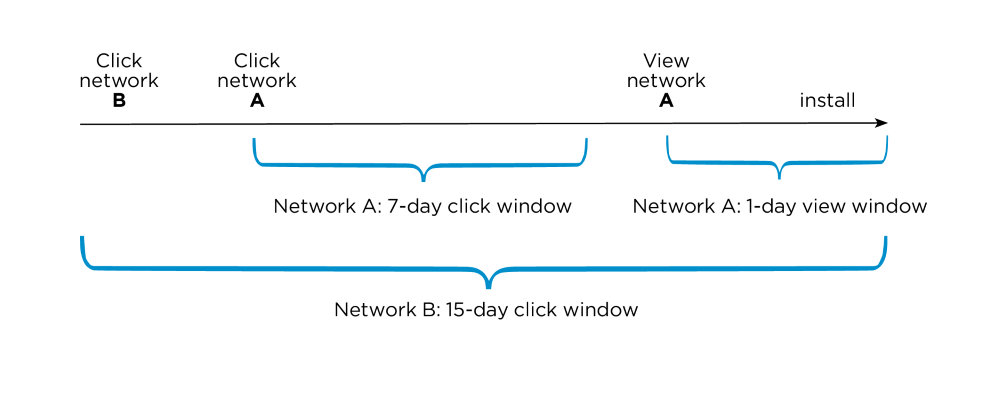
View-through attribution: The good, the bad, and the ugly

View-through attribution in app marketing occurs when an ad impression served to a user is given credit for delivering an app install.
This happens when the following conditions are both met:
- There is no click within the defined window (usually 7 days)
- The view occurred within its own defined window (usually 1 day)
In the following scenario, which network wins?

The answer: Network B.
Network B had the last click within a lookback window, while a click wins over a view – even if the latter is within its window.
Just like the iconic western starring Clint Eastwood, there are several forces at play when it comes to view through attribution.
The Good: Cross-funnel insights
Measuring the impact of ad views is an important piece of the mobile marketing puzzle.
After all, the concept of view-through has been around since the dawn of advertising: A billboard, a newspaper ad, even a TV ad – when people see these ads and later buy from the brands that advertised, that’s view through attribution, which has represented the lion’s share of advertising since the industry’s inception.
Advertising in all shapes and forms does not happen in a vacuum, and we are all influenced by things we see and messages we hear. And since the number of people who view ads before installing an app is much higher than the number of those who click on ads, the importance of consumer views in the overall purchase cycle is clear.
Of course, measuring the impact of viewing an ad offline was only possible by correlating the in-store sales lift during campaigns. And when the web emerged, all of that changed (mostly for the good; more on the bad further ahead).
In mobile, the fact that views can be measured and attributed in app-install campaigns offers important insights into an app marketer’s funnel: when and which media sources touched the user, what role did views play in driving users down the funnel, how many app installs were impacted by views, and of course how many installs ended up being attributed to views.
Impressions also play an increasingly important role in app marketing because of the growing use of video advertising.
Since videos are often viewed rather than clicked on, impression measurement and view-through attribution offers marketers performance insights into their video campaigns, which is quickly becoming a must-have channel for successful apps.
In addition, view-through attribution data is important for marketers in emerging markets where users often view ads but only install when they are connected to wifi.
The Bad: Viewability standard and billing challenges
An important distinction should be made between ads served and ads viewed. After all, Minority Report-style view measurement is still not available to guarantee 100% viewability…
In the real world, how can advertisers be sure that their served ads were actually viewed? How do marketers know that the insights in the campaign reports are accurate, not to mention view-driven billing figures. This issue became a major concern on the web where pages often had multiple ads: on top, on the side, below, popping up etc.
The web viewability standard was first introduced in 2004 by the IAB and MRC. In 2014, it was defined as having 50% or more of the ad’s pixels in-focus, in a browser tab, and on the viewable space of the browser page for at least one second post ad render. However, web viewability challenges remain because different ad units, browsers, ad placements, vendors, and measurement methodologies yield “wildly” different viewability numbers, according to the the IAB.
If the web is still grappling with a viewability standard, mobile is as well as it’s still the early days.
The MRC, MMA and IAB issued mobile viewability standards in April this year which stated that, like desktop, an ad is viewed if 50% of its pixels were in view for one second for display ads and two seconds for video ads. Moat was the first to be accredited for mobile viewability, followed by Integral Ad Science.
Where does that leave us? For now, running with media partners that are integrated with accredited firms will alleviate most concerns about non-viewable impressions. However, it won’t be able to generate the scale and media diversification you need. The good news is that there are several hundred networks that are capable of measuring viewability on their own so it’s important to understand what constitutes a viewable ad for each of your media partners.
How does the mobile measurement partner fit in here?
It relies on impression (and click) data sent by the media partner.
For example, if your video ad network reports views only after a video is completed, that’s the impression data an attribution provider will display and rely on for view-through attribution.
The bottom line is that you need to build a trusting relationship with your media partners.
At the same time, you need to monitor your post install performance, the impact of views as assisted installs, etc. to ensure that views you are building performance models on and paying for are delivering real, measurable value. Constant monitoring is especially important when running with networks that cannot measure viewability.
The Ugly: Fraud
Mobile ad fraud continues to taint mobile ad data. If you are running on CPM, it can be particularly painful as the IAB estimates invalid traffic costs mobile advertising $1.3 billion.
Although most performance-driven app marketers who focus on user acquisition do not run CPM campaigns, there are exceptions as some mobile ad networks only offer CPM. Also, the red-hot mobile video ad format – with its high payouts – is primarily CPM-driven.
How are impressions typically faked?
There are cases when fraudulent publishers stack multiple display ads (aka ad stacking) on the same piece of real estate. The advertiser is then charged for multiple views even though the user was only exposed to one ad; or when seemingly legitimate apps actually “hijack” a user’s app — which then runs in the background, serving hundreds of ads at a rate as high as 20 ads per minute.
Since it is relatively easy to generate a fake impression (when compared by degree of difficulty to a click, an install, and an in-app event), fraudsters generate millions of views, hoping to claim organic installs as their own by manipulating the view-through attribution mechanism.
The most important thing to understand when it comes to fighting fraud is that prevention is key.
The main prevention methods include:
- Active IP, user agent, and device ID filtering
- Distribution modeling to detect anomalies such as mean-time-to-install (MTTI)
- Device ranking which is a third critical layer of defense that fights fraud at the source – the device level
- Install and in-app receipt validation to validate the legitimacy of an install or in-app purchase by connecting to the app store’s servers.
To summarize, audience views have always played a key role in advertising. Understanding the impact of views on mobile app installs and post-install activity is another key piece of the puzzle app marketers need in order to drive success.




